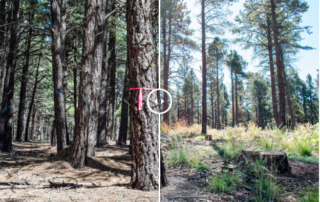Ponderosa Pine Ecosystem
Ponderosa Pine (Pinus ponderosa) is a large coniferous pine native to the western U.S. and Canada. Within this wide range, ponderosa pine grows across highly variable biophysical settings (e.g., soils, slopes, aspects, associated vegetation, and fauna). Ponderosa pine is three-needled, however, fascicles with both two and three needles can be found on the same tree. Ponderosa trees can withstand heat from most surface fires because of the insulating bark that protects the underlying cambial layers.
Southwestern ponderosa pine forests have undergone substantial changes in structure and function associated with livestock grazing, logging, and disruption of the natural frequent-fire regime following Euro-American settlement. Important compositional and structural changes in these forests resulting from human activities include increased tree densities, reduced structural and spatial heterogeneity of vegetation, less old trees on the landscape, and a decline in grass, forb, and shrub vegetation.
There is a breadth of research addressing historical stand structure, composition, and spatial heterogeneity of Ponderosa pine.

Fort Tuthill Before and After
The goals of forest restoration treatments are to [...]
Restoration Principles
Fort Tuthill Before and After
The goals of forest restoration treatments are to [...]
Full restoration of ponderosa pine forests in the southwest rely on historical evidences to dictate the number of trees left on a site. Full restoration (1.5/3) involves all the retention of all presettlement trees (pre Euro-American settlement). Replacement trees are left for each presettlement evidence dependent on size: if the replacement trees are more than 16 inches in diameter, 1.5 trees are left standing for each presettlement indicator. If they are smaller, 3 trees are left standing for each indicator.
Historical Lines of Evidence
Across the region, past management and lack of fire have allowed presettlement stumps, snags, and logs to persist on the landscape. These legacy structures can serve as a guide for the design of restoration treatments. Reconstructions of presettlement conditions, including age structure (the distribution and range of tree ages), serve as a basic point of reference central to restoration and management of these ecosystems. Reconstructions using historic evidence are around 91 percent accurate in blind comparisons to historic stem-maps. Restoration treatments retain all presettlement trees and use mechanical thinning followed by prescribed fire to reduce post-settlement stem densities and fuel loads.
Today’s forests are deficient in large, old trees, which have unique structural characteristics and represent centuries of genetic diversity. Old trees have greater genetic diversity than even-aged groups of young trees, the majority of which established post fire-exclusion. Trees that establish outside of their evolutionary envelope may lack key adaptive traits to survive natural disturbances. Additionally, trees 200+ years old have survived large climatic fluctuations and may provide forests a better chance of adapting to changing climatic conditions and other environmental factors.
Fire Regime
The historical fire regime is characterized by frequent low severity surface fires. The ability of the species to survive low severity wildfires is one of its most unique characteristics. Pre-1900 fire return intervals in southwestern ponderosa pine forests ranged from 2-15 years.
Spatial Heterogeneity
Historically, much of the southwestern ponderosa pine forests were naturally heterogeneous, with characteristic groups of trees and openings with a herbaceous understory that gave the forest an open, meadow-like appearance. Habitat heterogeneity is important to support a diversity of wildlife and plant species. The spatial pattern of trees and groups of trees retained following treatments via thinning and burning is an important factor affecting wildlife habitat quality in managed landscapes.
Understory
The herbaceous plant community, consisting of shrubs, grasses, sedges, and forbs is a vital part of ponderosa pine forest ecosystems. Fore restoration to be successful, however, the natural diversity and productivity of the understory plant community must be regained, and invasive or exotic understory species must be removed or maintained at tolerable levels.
Wildlife
Habitat heterogeneity is important to multiple wildlife species. Restoring the natural variability of forest composition and structure on the landscape can aid in restoring native wildlife populations, species diversity, and habitat quality. Important habitat components include aggregated tree patterns with grassy openings, a multi-layered canopy structure, snags, coarse woody debris, herbaceous understory, and seed and fungi sources.
Ponderosa Pine LEARN Sites
Gus Pearson Natural Area (GPNA), Coconino National Forest AZ
Fort Valley (FUWI), Coconino National Forest AZ
Grand Canyon NP (Kaibab National Forest) AZ
Apache Sitgreaves National Forest AZ
Mount Trumbull, AZ
Centennial Forest, Coconino National Forest AZ
Camp Navajo, AZ
Tusayan, Kaibab National Forest AZ

